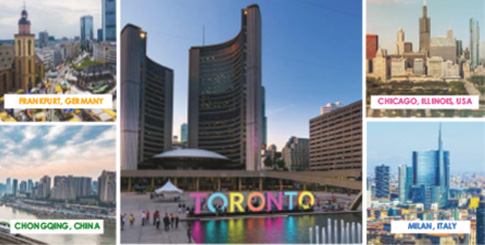Quito, Ecuador (friendship; 2006)
Quito, officially called San Francisco de Quito, is the capital of Ecuador. The city is home to nearly 2.7 million people and located at an elevation of 9,350 feet above sea level, making it the second highest capital city in the world. Quito has a subtropical highland climate, wet and dry seasons, and cool temperatures ranging from an average of 48 to 67°F.
Top industries include textiles, metals, and agriculture—major exports include coffee, sugar, cacao, tropical fruits (including bananas), and rice. Agriculture accounts for 6.2 percent of Ecuador’s GDP and employs nearly 28 percent of the country’s workforce.
Canada and Ecuador have been trade partners since 1960, with agricultural products making up the bulk of imports and exports between the two countries.
Rio de Janeiro, Brazil (friendship; 2015)
With a population of 6.4 million, Rio de Janeiro is home to even more residents than its sister city of Toronto. With a tropical savanna climate, Rio often experiences long periods of heavy rain from December to March. Temperatures vary according to elevation and distance from the coast, with averages ranging from 66 to 86°F and record highs of nearly 110°F.
Home to a booming economy, Rio has the second largest GDP in Brazil after São Paulo. The services sector accounts for the largest portion of GDP, followed by commerce, industrial business, and agriculture. Countrywide, agriculture represents 5.6 percent of Brazil’s GDP and employs 20 percent of the workforce. Brazil’s top crops include citrus, soybeans, rice, corn, sugarcane, and cocoa. Canada and Brazil have been strengthening trade ties in recent years with both imports and exports rising.
More Partnerships
As Toronto continues to forge ties with cities across the globe, such relationships contribute to better cultural understanding and promote economic development.
“I’ve always thought it was a neat concept,” remarks Sarraino. “It’s a great way to connect on cultural community activities shared between friendship cities and a great way to promote trade between partnership cities.”
If Toronto were to select an eleventh sister, Sarraino has a few thoughts: “I would choose a major city most similar to Toronto on a continent that is not currently represented,” he says, suggesting Sydney, Brisbane, Melbourne, Perth, or Adelaide in Australia or South Africa’s Johannesburg or Cape Town.
“I think Toronto is such a large city, it should partner with bigger metropolitan centers like Miami, Los Angeles, or Dallas,” shares Rubini. He adds it would also be a good idea to partner with a Mexican city.
“Since we’re part of NAFTA [the North American Free Trade Agreement],” Rubini suggests, “why not strengthen the relationship between Mexico and Canada? We already have a significant amount of trade between our countries, and we can further focus on more direct trade between our cities.”
Images:Claudio Divizia, softdelusion66, QinJin, marchello74, TRphotos/Shutterstock.com



